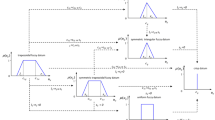Abstract
Graphical exploratory analysis for fuzzy data allows us to represent sets of individuals whose attributes are perceived with imprecision on a map so that the degree of dissimilarity between two objects is somehow compatible with the distances between their respective representations. This study will discuss the use of this tool to jointly analyze the evolution of a group of students during a course, and to select the most suitable personnel of a company to receive a training course, according to a catalog of competencies and considering the reliability of information sources.
Access this chapter
Tax calculation will be finalised at checkout
Purchases are for personal use only
Similar content being viewed by others
References
Couso I, Dubois D (2014) Statistical reasoning with set-valued information: ontic vs epistemic views. Int J Approx Reason 55:1502–1518
Couso I, Dubois D (2017) A general framework for maximizing likelihood under incomplete data. Int J Approx Reas 93:238–260
Couso I, Dubois D, Hüllermeier E (2017) Maximum likelihood estimation and coarse data. In: Moral S, Pivert O, Sánchez D, Marín N (eds) Scalable uncertainty management (Lecture notes in artificial intelligence), vol 10564. Springer, Cham
Couso I, Sánchez L (2008) Higher order models for fuzzy random variables. Fuzzy Sets Syst 159:237–258
Denœux T, Masson MH (2000) Multidimensional scaling of interval-valued dissimilarity data. Pattern Recognit Lett 21:83–92
Hebert PA, Masson MH, Denœux T (2006) Fuzzy multidimensional scaling. Comput Stat Data Anal 51:335–359
Honda K, Ichihashi H (2006) Fuzzy local independent component analysis with external criteria and its application to knowledge discovery in databases. Int J Approx Reason 42:159–173
Kim W, Choi B, Hong E-K, Kim S-K (2003) A taxonomy of dirty data. Data Min Knowl Discov 7:81–99
Kruskal JB (1964) Nonmetric multidimensional scaling: a numerical method. Psychometrika 29:115–129
Nuhfer E, Knipp D (2006) The use of a knowledge survey as an indicator of student learning in an introductory biology course. CBE Life Sci Educ 5:313–316
Mazza R, Milani C (2005) Exploring usage analysis in learning systems: Gaining insights from visualisations. In: proceedings of workshop usage analysis in learning systems. AEID, Amsterdam
Palacios A, Sánchez L, Couso I (2010) Diagnosis of dyslexia with low quality data with genetic fuzzy systems. Int J Approx Reason 51:993–1009
Sánchez L, Couso I, Otero J, Palacios A (2010) Assessing the evolution of learning capabilities and disorders with a graphical exploratory analysis of surveys containing missing and conflicting answers. Neural Netw World 20:825–838
Acknowledgements
We thank the editors of this volume for their kind invitation to participate. The research in this work has been supported by projects TIN2014-56967-R, TIN2017-84804-R and FC-15-GRUPIN14-073.
Author information
Authors and Affiliations
Corresponding author
Editor information
Editors and Affiliations
Rights and permissions
Copyright information
© 2018 Springer International Publishing AG
About this chapter
Cite this chapter
Couso, I., Junco, L., Otero, J., Sánchez, L. (2018). Graphical Exploratory Analysis of Fuzzy Data as a Teaching Tool. In: Gil, E., Gil, E., Gil, J., Gil, M. (eds) The Mathematics of the Uncertain. Studies in Systems, Decision and Control, vol 142. Springer, Cham. https://doi.org/10.1007/978-3-319-73848-2_52
Download citation
DOI: https://doi.org/10.1007/978-3-319-73848-2_52
Published:
Publisher Name: Springer, Cham
Print ISBN: 978-3-319-73847-5
Online ISBN: 978-3-319-73848-2
eBook Packages: EngineeringEngineering (R0)




